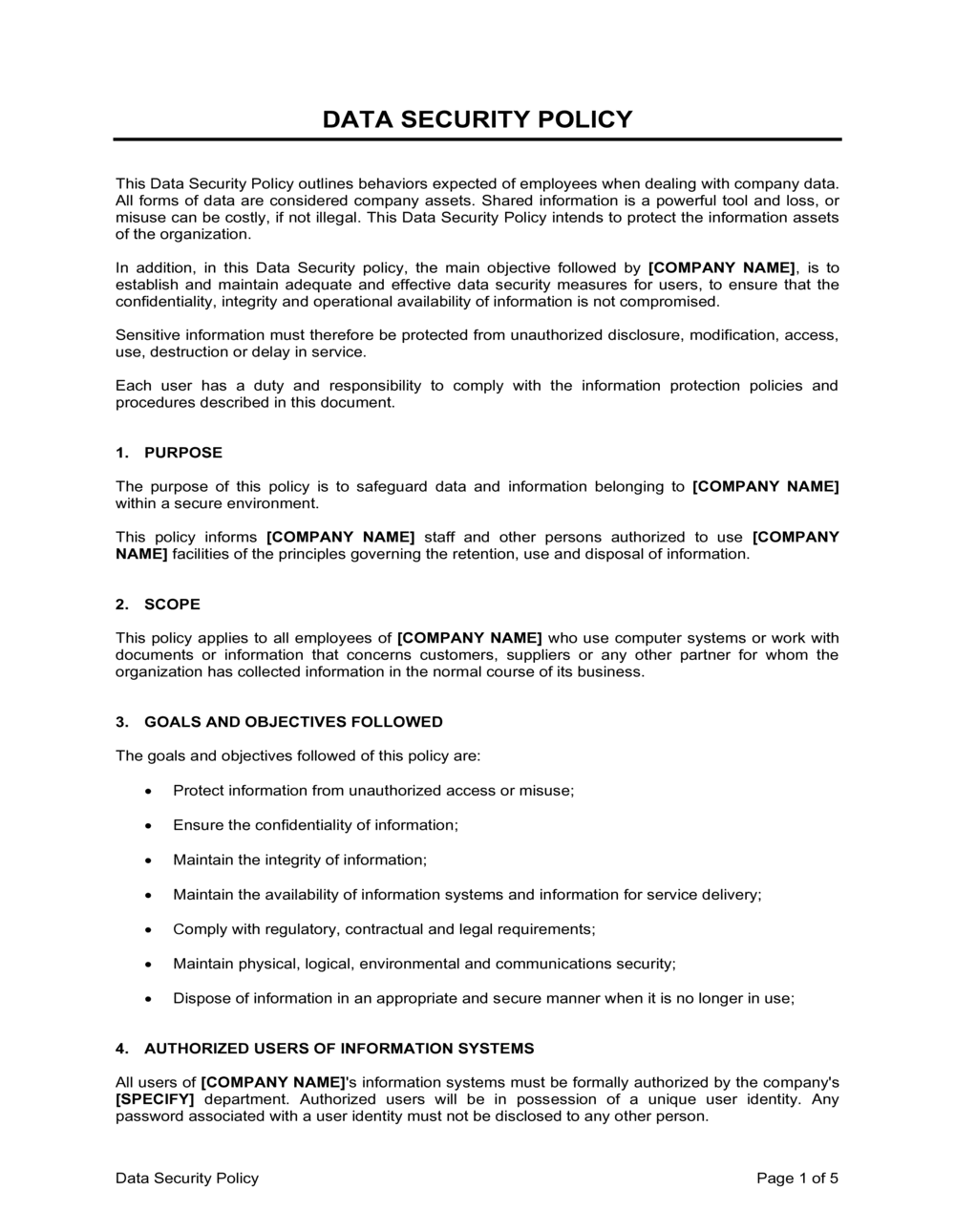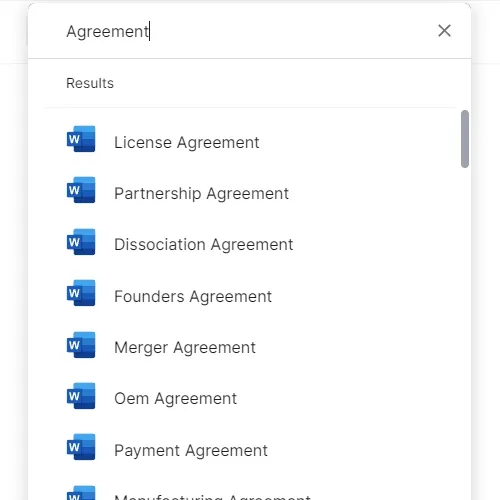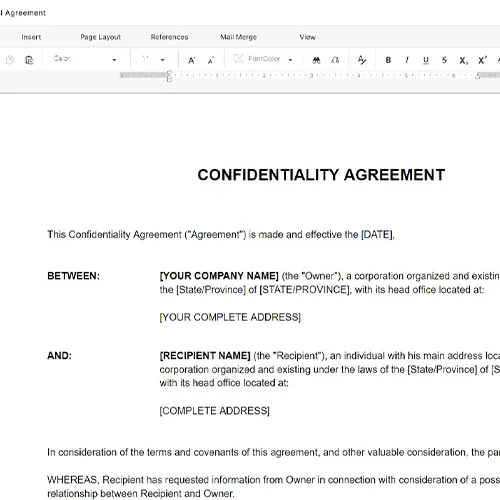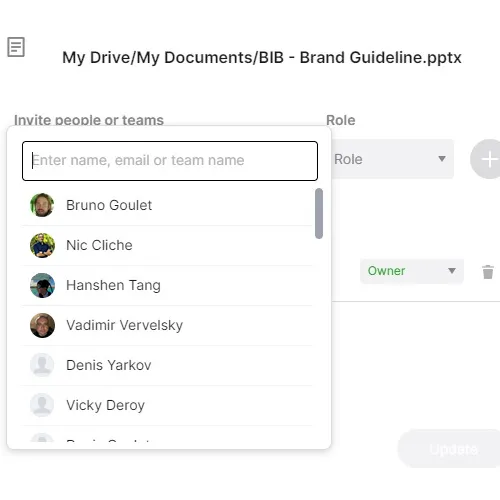Data Security Policy Template

Understanding a Data Security Policy
A Data Security Policy is a crucial document for any organization that handles data, particularly sensitive or personal information. It outlines the standards, procedures, and protocols for ensuring the security and confidentiality of data. This policy is essential for minimizing the risk of data breaches, protecting against unauthorized access, and maintaining trust with clients and stakeholders.
What is a Data Security Policy?
A Data Security Policy is an essential framework that defines an organization’s protocols and strategies for protecting its data assets. This comprehensive document provides clear guidelines on the management of digital and physical data, ensuring robust protection against unauthorized access, data breaches, and other security threats. It establishes a standardized approach to data handling practices, including:
- Purpose and Scope - Clarifies the objectives of the policy, specifying which data is covered and the environments to which the policy applies, ensuring all data forms are addressed.
- Data Classification - Categorizes data based on sensitivity and criticality, assigning security measures tailored to the level of confidentiality and risk associated with each category.
- Roles and Responsibilities - Outlines the duties of specific roles within the organization, including data protection officers and IT staff, as well as the security responsibilities of general employees.
- Access Control - Details protocols for controlling access to sensitive data, utilizing user authentication, authorization levels, and other security mechanisms to restrict access appropriately.
- Data Encryption - Mandates encryption standards for data at rest and in transit, providing guidelines for the encryption technologies and processes used.
- Physical Security - Incorporates strategies to protect the physical facilities and devices where data is stored or processed, such as secure storage rooms and anti-surveillance measures.
- Incident Response - Defines the actions to be taken in response to data security incidents, outlining processes for identification, investigation, containment, and recovery.
- Employee Training - Emphasizes the importance of regular security training for employees, ensuring they are aware of and understand the data security practices and compliance requirements.
- Third-Party Vendor Management - Sets forth security expectations and responsibilities for third-party vendors who access or manage the organization's data, ensuring their practices align with the organization’s security standards.
- Audit and Compliance - Specifies the schedule and procedures for periodic security audits to assess policy compliance and the effectiveness of implemented security measures.
- Review and Update - Describes the process for periodically reviewing and updating the policy to adapt to evolving security challenges, technological advancements, and legal and regulatory framework changes.
This structured document is not only a set of rules but also a dynamic tool that adapts to new threats and technologies, ensuring that data security remains a top priority across all facets of the organization.
Supporting Documents for Structuring a Data Security Policy
To enhance the effectiveness of a Data Security Policy, integrating related documents is advisable:
- Data Retention and Destruction Policy - Specifies protocols for the systematic storage and secure disposal of data, detailing the duration for which different types of data should be retained and the methods for their safe elimination when they are no longer required.
- Access Control Policy - Establishes rigorous guidelines for controlling who can access specific types of organizational data, including procedures for granting, managing, and revoking access rights to safeguard sensitive information.
- Information Security Policy - A comprehensive policy that addresses the full spectrum of IT security measures, extending beyond data protection to include network security, endpoint security, and the management of IT infrastructure.
- Incident Response Plan - Outlines precise protocols for responding to security incidents, detailing steps for rapid detection, effective containment, and recovery, thus ensuring a coordinated response to minimize impact and restore normal operations.
Why Utilize a Comprehensive Template for a Data Security Policy?
Using a well-structured template for drafting a Data Security Policy offers significant benefits:
- Enhanced Security - Provides robust guidelines that help prevent unauthorized access, data leaks, and other security threats.
- Regulatory Compliance - Ensures the organization adheres to legal and regulatory requirements related to data protection, avoiding fines and legal penalties.
- Reputation Management - Protects the organization’s reputation by demonstrating a commitment to data security.
- Operational Continuity - Minimizes disruptions caused by data breaches and ensures smooth business operations.
Adopting a comprehensive Data Security Policy is crucial for any organization that values data integrity and security. It not only protects sensitive information but also supports trust and compliance, which are vital for long-term success.
Updated in May 2024
3,000+ Templates & Tools to Help You Start, Run & Grow Your Business

Understanding a Data Security Policy
A Data Security Policy is a crucial document for any organization that handles data, particularly sensitive or personal information. It outlines the standards, procedures, and protocols for ensuring the security and confidentiality of data. This policy is essential for minimizing the risk of data breaches, protecting against unauthorized access, and maintaining trust with clients and stakeholders.
What is a Data Security Policy?
A Data Security Policy is an essential framework that defines an organization’s protocols and strategies for protecting its data assets. This comprehensive document provides clear guidelines on the management of digital and physical data, ensuring robust protection against unauthorized access, data breaches, and other security threats. It establishes a standardized approach to data handling practices, including:
- Purpose and Scope - Clarifies the objectives of the policy, specifying which data is covered and the environments to which the policy applies, ensuring all data forms are addressed.
- Data Classification - Categorizes data based on sensitivity and criticality, assigning security measures tailored to the level of confidentiality and risk associated with each category.
- Roles and Responsibilities - Outlines the duties of specific roles within the organization, including data protection officers and IT staff, as well as the security responsibilities of general employees.
- Access Control - Details protocols for controlling access to sensitive data, utilizing user authentication, authorization levels, and other security mechanisms to restrict access appropriately.
- Data Encryption - Mandates encryption standards for data at rest and in transit, providing guidelines for the encryption technologies and processes used.
- Physical Security - Incorporates strategies to protect the physical facilities and devices where data is stored or processed, such as secure storage rooms and anti-surveillance measures.
- Incident Response - Defines the actions to be taken in response to data security incidents, outlining processes for identification, investigation, containment, and recovery.
- Employee Training - Emphasizes the importance of regular security training for employees, ensuring they are aware of and understand the data security practices and compliance requirements.
- Third-Party Vendor Management - Sets forth security expectations and responsibilities for third-party vendors who access or manage the organization's data, ensuring their practices align with the organization’s security standards.
- Audit and Compliance - Specifies the schedule and procedures for periodic security audits to assess policy compliance and the effectiveness of implemented security measures.
- Review and Update - Describes the process for periodically reviewing and updating the policy to adapt to evolving security challenges, technological advancements, and legal and regulatory framework changes.
This structured document is not only a set of rules but also a dynamic tool that adapts to new threats and technologies, ensuring that data security remains a top priority across all facets of the organization.
Supporting Documents for Structuring a Data Security Policy
To enhance the effectiveness of a Data Security Policy, integrating related documents is advisable:
- Data Retention and Destruction Policy - Specifies protocols for the systematic storage and secure disposal of data, detailing the duration for which different types of data should be retained and the methods for their safe elimination when they are no longer required.
- Access Control Policy - Establishes rigorous guidelines for controlling who can access specific types of organizational data, including procedures for granting, managing, and revoking access rights to safeguard sensitive information.
- Information Security Policy - A comprehensive policy that addresses the full spectrum of IT security measures, extending beyond data protection to include network security, endpoint security, and the management of IT infrastructure.
- Incident Response Plan - Outlines precise protocols for responding to security incidents, detailing steps for rapid detection, effective containment, and recovery, thus ensuring a coordinated response to minimize impact and restore normal operations.
Why Utilize a Comprehensive Template for a Data Security Policy?
Using a well-structured template for drafting a Data Security Policy offers significant benefits:
- Enhanced Security - Provides robust guidelines that help prevent unauthorized access, data leaks, and other security threats.
- Regulatory Compliance - Ensures the organization adheres to legal and regulatory requirements related to data protection, avoiding fines and legal penalties.
- Reputation Management - Protects the organization’s reputation by demonstrating a commitment to data security.
- Operational Continuity - Minimizes disruptions caused by data breaches and ensures smooth business operations.
Adopting a comprehensive Data Security Policy is crucial for any organization that values data integrity and security. It not only protects sensitive information but also supports trust and compliance, which are vital for long-term success.
Updated in May 2024
Easily Create Any Business Document You Need in Minutes.

Access over 3,000+ business and legal templates for any business task, project or initiative.

Customize your ready-made business document template and save it in the cloud.

Share your files and folders with your team. Create a space of seamless collaboration.
Templates and Tools to Manage Every Aspect of Your Business.
Business in a Box Covers Every Business Department
Includes 16 Types of Business Documents You Need
and Achieve Your Business Goals Faster.
